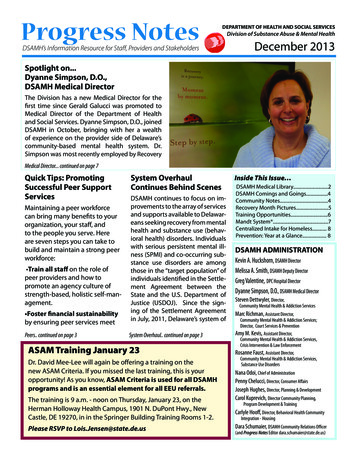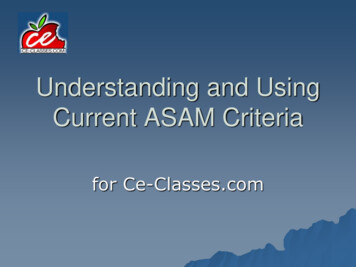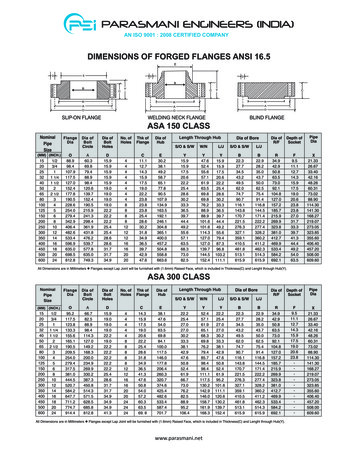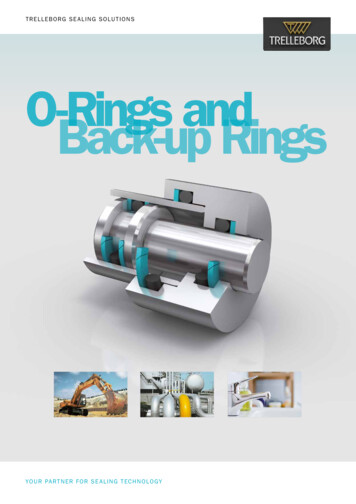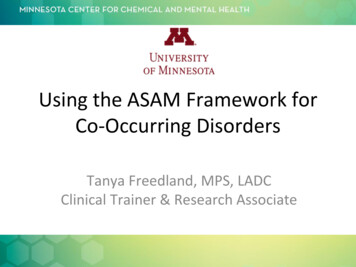
Transcription
Using the ASAM Framework forCo-Occurring DisordersTanya Freedland, MPS, LADCClinical Trainer & Research Associate
ASAM BasicsWhat is ASAM?Fees, T. (2013). The ASAM criteria: Treatment criteria foraddictive, substance-related and co-occurring conditions.
ASAM BasicsWhat is ASAM? Guide for providers to develop care plans Make objective decisions about placementalong the continuum of careFees, T. (2013). The ASAM criteria: Treatment criteria foraddictive, substance-related and co-occurring conditions.
ASAM BasicsWhat is ASAM?Fees, T. (2013). The ASAM criteria: Treatment criteria foraddictive, substance-related and co-occurring conditions.
ASAM BasicsGuiding Principles of ASAM Criteria Moving from one dimensional tomultidimensional assessment Moving from program driven treatment toclinically driven and outcomes driven treatment Moving from fixed to variable length oftreatmentFees, T. (2013). The ASAM criteria: Treatment criteria foraddictive, substance-related and co-occurring conditions.
ASAM BasicsGuiding Principles of ASAM Criteria Moving from limited number of levels of careto broad and flexible continuum of care Identifying specific needs of adolescents Clarifying goals of treatmentFees, T. (2013). The ASAM criteria: Treatment criteria foraddictive, substance-related and co-occurring conditions.
ASAM BasicsGuiding Principles of ASAM Criteria Moving away from treatment failure as aprerequisite for admission Moving toward multidisciplinary team-basedcare Clarifying physician role in care Focusing on treatment outcomesFees, T. (2013). The ASAM criteria: Treatment criteria foraddictive, substance-related and co-occurring conditions.
ASAM BasicsElements of a Biopsychosocial Assessment Description of present episodeFamily HistoryDevelopmental HistorySubstance use and addictive behavior historySocial and legal historyPsychiatric HistoryMedical historyFees, T. (2013). The ASAM criteria: Treatment criteria foraddictive, substance-related and co-occurring conditions.
ASAM BasicsElements of a Biopsychosocial Assessment Spiritual historyReview of symptomsMental status examinationPhysical examinationFormulation and diagnosisSurvey of assets, vulnerabilities, and supportTreatment recommendationsFees, T. (2013). The ASAM criteria: Treatment criteria foraddictive, substance-related and co-occurring conditions.
Dimensional RatingWhat are risk ratings and why do we care?
Dimension 1Acute IntoxicationandWithdrawalPotential
Dimensional RatingDimension 1 - Assessment Considerations Are there risks with client’s current level ofintoxication or withdrawal? If so, what are they? Is there a history of severe withdrawalsymptoms?Fees, T. (2013). The ASAM criteria: Treatment criteria foraddictive, substance-related and co-occurring conditions.
Dimensional RatingDimension 1 - Assessment Considerations Are services needed to address currentintoxication or withdrawal? Is ambulatory withdrawal safe to consider?Fees, T. (2013). The ASAM criteria: Treatment criteria foraddictive, substance-related and co-occurring conditions.
Dimensional RatingWithdrawal Warning Signs - Alcohol and Benzos 2 hours to 4 days after stopping drinkingHeadache, fast heart rate, or insomniaNausea, vomiting, or lack of appetiteTremors, shakiness, restlessnessAnxiety, agitation, or irritabilityHallucinations or disorientationSeizures or insomnia
Dimensional RatingSarah Self referred for care due to anxiety and depression Used meth and cannabis heavily over the past 2years Not using meth now, last use was a week prior toassessment Using cannabis regularly, in the morning for anxietyand at night to go to sleep Risk rating 0
Dimensional RatingRon Referred from corrections after being arrested under the influence for assaultDrinks heavily, more than 5 standard drinks perdayReports that he hasn’t had a drink for 24 hoursAppears sweaty, shaky, and is having a difficulttime engaging in conversationsRisk rating 3
Dimension 2Biomedical Conditions and Concerns
Dimensional RatingDimension 2 - Assessment Considerations Are there current physical illnesses that needcare? Are chronic illnesses or conditions in need ofstabilization?Fees, T. (2013). The ASAM criteria: Treatment criteria foraddictive, substance-related and co-occurring conditions.
Dimensional RatingDimension 2 - Assessment Considerations Does the client have a communicable diseasethat impacts others? Is the client pregnant? (especially importantfor opioid use disorders)Fees, T. (2013). The ASAM criteria: Treatment criteria foraddictive, substance-related and co-occurring conditions.
Dimensional RatingSarah Has lower back pain since her 20’s (39 years old currently)Has been prescribed pain medications, butdoesn’t believe that they helpReports history of fibromyalgia that flares upand causes problemsHas no regular primary care and is open to itRisk rating 1
Dimensional RatingRon Denies any medical concerns Smokes 1-2 packs of cigarettes per day Does not like doctors and avoids going at allcosts Has a black eye and a finger that appears to bebroken Reports that he did not receive medical carewhile in custody Risk rating 2
Dimension 3EmotionalBehavioral orCognitiveConditions andComplications
Dimensional RatingDimension 3 - Assessment Considerations Are there current psychological, behavioral,emotional, or cognitive issues that need to beaddressed? are there chronic conditions that needstabilization? (e.g. bipolar disorder or chronicanxiety)Fees, T. (2013). The ASAM criteria: Treatment criteria foraddictive, substance-related and co-occurring conditions.
Dimensional RatingDimension 3 - Assessment Considerations Do symptoms appear to connect to theaddiction or are they separate? Most people with Substance Use Disordershave problems in this dimension related totheir disorder and it is difficult to tell if theseare separate until there is a period ofrecovery.Fees, T. (2013). The ASAM criteria: Treatment criteria foraddictive, substance-related and co-occurring conditions.
Dimensional RatingDimension 3 - Assessment Considerations Are any of the signs or symptoms severeenough to need mental health treatment? Can the client cope with emotional,behavioral, or cognitive conditions? Is the client able to manage the activities ofdaily life?Fees, T. (2013). The ASAM criteria: Treatment criteria foraddictive, substance-related and co-occurring conditions.
Dimensional RatingDimension 3 - Risk Domains Dangerousness and lethality Likelihood of self harm or harm to others History of impulsivity Immediacy of riskFees, T. (2013). The ASAM criteria: Treatment criteria foraddictive, substance-related and co-occurring conditions.
Dimensional RatingDimension 3 - Risk Domains Interference with Recovery Efforts– Mental Illnesses interference with substance usedisorder recovery– Substance Use Disorders interference withmental health recoveryFees, T. (2013). The ASAM criteria: Treatment criteria foraddictive, substance-related and co-occurring conditions.
Dimensional RatingDimension 3 - Risk Domains Social Functioning How much does a person’s substance useinterfere with relationships Does the use prevent a person from fulfillingroles and responsibilities?Fees, T. (2013). The ASAM criteria: Treatment criteria foraddictive, substance-related and co-occurring conditions.
Dimensional RatingDimension 3 - Risk Domains Ability for Self-Care Impairment in ability to bathe or wearappropriate clothing Does the substance use affect the ability toobtain food and shelter?Fees, T. (2013). The ASAM criteria: Treatment criteria foraddictive, substance-related and co-occurring conditions.
Dimensional RatingDimension 3 - Risk Domains Course of Illness History of chronicity of illness Acute signs and symptoms Instability leads to higher risk ratingsFees, T. (2013). The ASAM criteria: Treatment criteria foraddictive, substance-related and co-occurring conditions.
Dimensional RatingSarah Youngest of 4 children mother and fatherdivorced when she was 10 Reported reading difficulties but was able toovercome them Interest in school declined during high school asfriends became more important Did not go to college and has been employed inretail
Dimensional RatingSarah Reports feeling depressed most of the day, every day and is having difficulty getting to workShe has had episodes like this since middle schoolWakes up anxious and on edgeShe reports she is very tired but cannot sleep wellPassing suicidal thoughts but reports she wouldnever act on themRisk rating 2
Dimensional RatingSarah Began using cannabis in at age 14 and has beensmoking consistently since then, except duringpregnancy Drinking began at age 15, but does not drink morethan 3 times per month, 2 drinks per episode Meth use started in mid 20’s she indicates she oftenuses when she feels really bad and it doesn’t go away Risk rating 2
Dimensional RatingRon Oldest child of 6, parents remain married butwere not affectionate with each other No history of mental illness in the family butreports that everyone drinks Had difficulty getting along with others inschool and struggled with learning
Dimensional RatingRon No history of mental health care Reports no symptoms of note but indicates hismood is low and has been that way for a longtime Does not have suicidal thoughts, but sometimesthinks about killing his boss when he is angryabout a work assignment States he needs his job and would never act on it
Dimensional RatingRon Regular drinking started when he was in high school and partied on the weekendsWent to community college for welding and begandrinking daily 2-4 beersStarted drinking whiskey in early 30’s, it took theedge off better and helped him deal with his wifeHas been drinking 2 glasses of whiskey and a 6-packof beer per day since divorce 3 years agoRisk rating 1
Dimension 4Readiness toChange
Dimensional RatingDimension 4 - Assessment Considerations How aware is the client of the relationshipbetween their substance use or behaviors ofpathological reward seeking and theconsequences of those behaviors? What is their readiness to change in otherareas? Mental Health, Employment, PhysicalHealth, etc.Fees, T. (2013). The ASAM criteria: Treatment criteria foraddictive, substance-related and co-occurring conditions.
Dimensional RatingDimension 4 - Assessment Considerations How ready, willing, or able is the client tochange? How much control does the client feel theyhave over the services they receive?Fees, T. (2013). The ASAM criteria: Treatment criteria foraddictive, substance-related and co-occurring conditions.
Dimensional RatingSarah Reports she wants to get better and needshelp Skeptical of therapy but thinks thattreatment can help her stop using meth andcannabis Usually drops out of therapy after onesession Risk rating 1 SUD, 2 MI
Dimensional RatingRon Is willing to do the assessment, just to get itover with Doesn’t believe in ”shrinks” Wants to get on with his life If told to go to treatment, would fight it incourt Risk rating 3 SUD, 3 MI
Dimension 5RelapseContinuedUse orContinuedProblemPotential
Dimensional RatingDimension 5 - What is Relapse?The return to active addiction after a period ofrecoveryThe return of active illness or problem behaviorafter a period of recoveryFees, T. (2013). The ASAM criteria: Treatment criteria foraddictive, substance-related and co-occurring conditions.
Dimensional RatingDimension 5 - Assessment Considerations Is the client in immediate danger of severemental health issues or continued substanceuse? Does the client have any understanding ofcoping skills to manage relapse continued useor continued problems?Fees, T. (2013). The ASAM criteria: Treatment criteria foraddictive, substance-related and co-occurring conditions.
Dimensional RatingDimension 5 - Assessment Considerations Have medications helped with recovery in thepast? What are the client’s skills for coping withcravings, withdrawal, or impulses? How well can the client cope with negativeemotions, peer pressure, stress and thoughtsof substance use?Fees, T. (2013). The ASAM criteria: Treatment criteria foraddictive, substance-related and co-occurring conditions.
Dimensional RatingDimension 5 - Assessment Considerations How severe are the problems and distressexperienced by the client if they are notengaged in treatment and continue to usesubstances, engage in addictive behaviors, orhave mental health problems?Fees, T. (2013). The ASAM criteria: Treatment criteria foraddictive, substance-related and co-occurring conditions.
Dimensional RatingDimension 5 - Assessment Considerations How aware is the client about relapse triggersand skills to control substance use impulsesand also impulses to harm self or others?Fees, T. (2013). The ASAM criteria: Treatment criteria foraddictive, substance-related and co-occurring conditions.
Dimensional RatingSarah Had periods where she stopped using meth, usually when not feeling depressedDoes not remember what it was like when shedidn’t smoke cannabisIndicates marijuana keeps her from getting toodownDepression occurs 1-2 times annually and shemanages it by using methRisk rating 2 SUD, 3 MI
Dimensional RatingRon Has never tried to quit drinking Has never received mental health care Does not recognize symptoms or have skillsto avoid use or anger Risk rating 3 SUD, 3 MI
Dimension 6Recovery orLivingEnvironment
Dimensional RatingDimension 6 - Assessment Considerations Do any family members, significant others,living situations, work, or school threaten theclient’s safety or engagement in treatmentactivities?Fees, T. (2013). The ASAM criteria: Treatment criteria foraddictive, substance-related and co-occurring conditions.
Dimensional RatingDimension 6 - Assessment Considerations Does the client have supportive friends,financial resources, work or educationalresources that will contribute to recovery?Fees, T. (2013). The ASAM criteria: Treatment criteria foraddictive, substance-related and co-occurring conditions.
Dimensional RatingDimension 6 - Assessment Considerations Are there legal, vocational, regulatory (e.g.licensure), social services, or criminal justicemandates that will enhance a client’smotivation for engaging in treatmentFees, T. (2013). The ASAM criteria: Treatment criteria foraddictive, substance-related and co-occurring conditions.
Dimensional RatingSarah Employed at a clothing store and is in danger ofbeing fired because of missing so much work due topersonal struggles and binges Teenage children are currently with their fatherbecause her problems have kept her from beingable to parent Her family has encouraged her to attend treatmentand want her to get better Risk rating 0
Dimensional RatingRon Works as a welder at a manufacturing company for the past 9 yearsMultiple arrests on record for fighting, likely facingjail time for this chargeDivorced 3 years ago and lives aloneHas limited contact with adult children, they areupset about the way he handled the divorceReports all his friends drink like he doesRisk rating 2
ASAM Limitations Developed for SUD care and adapted toinclude COD issues Difficult to use in setting that provide both MIand SUD care where not all clients have COD Not appropriate for young children Challenging to determine dimensions for careplanning and documentation Often requires separate ratings for SUD andMI rather than true integration
mncamh@umn.edufree0165@umn.edu
Dimensional Rating Sarah Began using cannabis in at age 14 and has been smoking consistently since then, except during pregnancy Drinking began at age 15, but does not drink more than 3 times per month, 2 drinks per episode Meth use started in mid 20’s she indicates she of
